PHYSICAL SCIENCES: PHYSICS PAPER 1 GRADE 12 MEMORANDUM - NSC PAST PAPERS AND MEMOS FEBRUARY/MARCH 2018
Share via Whatsapp Join our WhatsApp Group Join our Telegram GroupPHYSICAL SCIENCES: PHYSICS
PAPER 1
GRADE 12
NSC PAST PAPERS AND MEMOS
FEBRUARY/MARCH 2018
MEMORANDUM
QUESTION 1
1.1 A✔✔ (2)
1.2 B✔✔ (2)
1.3 C✔✔ (2)
1.4 B✔✔ (2)
1.5 A✔✔ (2)
1.6 B✔✔ (2)
1.7 C✔✔ (2)
1.8 C✔✔ (2)
1.9 D✔✔ (2)
1.10 B✔✔ (2) [20]
QUESTION 2
2.1. A body will remain in its state of rest or motion at constant velocity unless a non-zero resultant/net force acts on it. ✔✔ (2)
2.2
Accepted labels | |
w | Fg / Fw/weight / mg / gravitation force |
T | FT/tension |
fk | (Kinetic) Friction / Ff / 4 N / f / wrywing / Fw |
N | FNormal / Normal / FN |
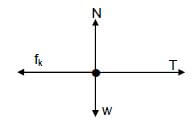 (4)
(4)
Notes
- Mark awarded for label and arrow
- Do not penalise for length of arrows since drawing is not to scale.
- Any other additional force(s) 3/4
- If force(s) do not make contact with body 3/4
2. 3 Object Q
- Fnet = ma
Fnet = 0
T + (fk) = ma
T - 3 ✔ = 0 ✔
T = 3 N
Object P
- Fnet = ma
Fhor - (fk +T) = ma✔
(Fcos 30o) - 5 - 3 = 0 ✔
F = 9,24 N✔ (9,238 N) (6)
2.4 3 s✔ (1)
2.5 Y✔
- Graph Y represents the motion of Q after the string breaks.
The graph Y shows a decreasing velocity ✔with a negative acceleration. ✔
This is because the net force (friction) acting on Q is in the opposite direction to its motion,✔ (accept: only frictional force acts on Q). (4) [17]
QUESTION 3
3.1 10 m∙s-1✔ (1)
3.2 The gradient represents the acceleration due to gravity (g) which is constant for free fall. ✔ [The graphs represent free fall] (1)
3.3.1 POSITIVE MARKING FROM QUESTION 3.1
| OPTION 1 | |
| Δy = viΔt + ½ aΔt2 ✔ = (10)(2) + ½ (9,8)( 22) ✔ = 39,6 m Height = 39,6 m ✔ | Δy = viΔt + ½ aΔt2✔ = (-10)(2) + ½ (-9,8)( 22)✔ = -39,6 m Height = 39,6 m ✔ |
OPTION 2 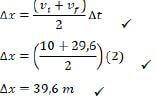 | OPTION 3 |
| OPTION 4 Height = Area under the graph or [Any one ✔] =Area of + Area of = (10)(2)+(½)(2)(19,6) ✔ = 39,6 m ✔ | |
OPTION 5 | |
3.3.2
| OPTION 1 vf = vi + aΔt✔ 0 = -25 + (9,8)( Δt ) ✔ Δt = 2,55 s Total time T = 8 +2,55 ✔ = 10,55 s✔ | OPTION 2 |
OPTION 3 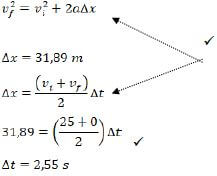 Total time T = 8 +2,55 ✔ = 10,55 s✔ | OPTION 4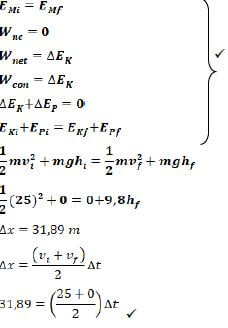 Total time T = 8 +2,55 ✔ = 10,55 s ✔ |
| OPTION 5 Slope of graph = 9,8 = 0 - (-25) T - 8 Total time T = 8 +2,55 ✔ = 10,55 s✔ | If values of vi and vf are swopped around,and a negative time is obtained, give 1 mark for formula and 1 mark for adding calculated time to 8 s, (max 2/4). |
3.4.1 0,2 s✔ (1)
3.4.2 4,955 s✔✔ (2)
3.4.3 - 27 (m.s-1) ✔ [Must include the negative] (1)
3.5 Inelastic.✔
- The speeds at which it strikes and leaves the ground are not the same/The kinetic energies will not be the same ✔ (2) [16]
QUESTION 4
4.1
- The total linear momentum of a closed (isolated) system remains constant (is conserved). ✔✔
OR - In an isolated system, the total linear momentum before collision is equal to the total linear momentum after collision ✔✔
(If key words isolated and total missing -1 mark for each.) (2)
4.2
- Formulae either
- ∑p = ∑pf
OR - m1v1i + m2v2i = m1v1f + m2v2f
Any one
- ∑p = ∑pf
- For the system cat-skate board A
(3,5)(0) + (2,6)(0) ✔ = (3,5)vskateboard + (2,6)(3) ✔
Vskateboard = 2,23 m∙s-1✔ to the left✔
ACCEPT v = -2,23 m∙s-1✔✔ (5)
4.3 Fnet Δt = Δp = mvf - mvi✔
- = (3,5)(1,28 - 0) ✔
= 4,48 N∙s (4,48 kg∙ms-1)✔
OR
Fnet Δt = Δp = mvf - mvi✔
- = (2,6)(1,28 - 3) ✔
= -4,48 N∙s (4,48 kg∙ms-1)
∴ Δp = 4,48 N.s✔ (3) [10]
QUESTION 5
5.1 The total mechanical energy/sum of kinetic and gravitational potential energy in a closed/isolated system is constant (conserved).✔✔
(If key words isolated and total missing -1 mark for each.) (2)
5.2
- E MECH P = E MECH Q
(EP + EK)P = (EP + E K )Q
✔1 mark for any of the three
Wnet = ΔEk
Wcon = ΔEk - (mgh + 1/2 mv2)P = (mgh + 1/2 mv2)Q
50 (9,8)(3) + 0 ✔= 0 + ½ (50)v2✔
v = 7,67 m∙s-1 ✔ (7,668 m∙s-1 ) (4)
5.3
| Accepted labels | ||
| w | Fg / Fw / weight / mg / gravitational force | ✔ |
| N | FN | ✔ |
| fk | Ff/friction/f | ✔ |
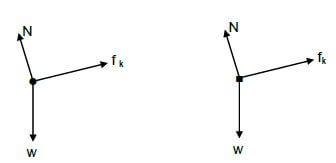 (3)
(3)
Notes
- Mark awarded for label and arrow
- Do not penalise for length of arrows since drawing is not to scale.
- Any other additional force(s) Max/Maks 2/3
- If force(s) do not make contact with body: Max/Maks: 2/3
5.4
- fk = μkN
= µk (mgcosθ) ✔ Any one/Enige een
= 0,08 (50 x 9,8) cos 30o✔
= 33,95 (33, 948) N ✔ (3)
NOTE: IN ALL THE OPTIONS FOR QUESTION 5.5 BELOW, ACCEPT THE SUBSTITUTION:
5 cos 60o IN PLACE OF/IN PLAAS VAN 5 sin 30o
5.5 OPTION 1
POSITIVE MARKING FROM QUESTION 5.4
- W = Fnet∆x cosθ
Wnet = Wf + Ww + WN
Wnet = Wf + (-∆ EP) + WN
Wnet = fk ∆x cos180 o + mgsinθ ∆xcos0 + 0 Wnet = ∆ EK/∆ K
Wnet = [33,948)(5)(-1)] + [(50)(9,8) (5)sin 30 o + 0]✔
= 1055, 26 (1055,259)
1055,259 = ½ (50) (vf 2 - 7,6682) ✔
vf = 10,05 m∙s-1✔
OPTION 2
POSITIVE MARKING FROM QUESTION 5.2
- Wnc = ΔEp + ΔEk
fΔxcosθ = (mghf - mghi) + ( ½ mvf2 - ½ mvi2)
1 mark for any of the two/
μmg∆x cos180 o = [ 0 - (mg∆x sin 30 o ] + ½ m(vf2 - vi2)
[33,948)(5)(-1)] = [0 - 50(9,8) (5) sin 30 o ]✔+ ½ (50) (vf 2 - 7,6682 )✔
vf = 10,05 m∙s-1✔
OPTION 3
POSITIVE MARKING FROM QUESTION 5.2 AND 5.4
- Wnc = ΔEp + ΔEk
f Δxcosθ = (mghf - mghi) + ( ½ mvf2 - ½ mvi2)
1 mark for any of the two
(33,95)(5) cos 180 ✔= [(50)(9,8) {0 - 5 sin30o}]✔ + ½ (50)( vf2 - 7,6682) ✔
vf = 10,05 m∙s-1✔ (5) [17]
QUESTION 6
6.1 An (apparent) change in the observed frequency (pitch), (wavelength) ✔as a result of the relative motion between a source and an observer ✔(listener). (2)
6.2 Towards A.✔
- Recorded frequency higher.✔ (2)
6.3
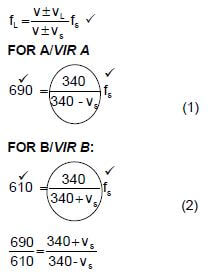
1,131 (340 - vs) = 340 + vs
vs = 20,90 m.s-1✔ (20.90 to 20.92 m.s-1) (6)
6.4 ANY ONE
- Doppler flow meter ✔
- Measuring foetal heartbeat
- Measure speed of blood flow
- Ultra sound
- Sonar
- Radar (for speeding) (1) [11]
QUESTION 7
7.1 The magnitude of the electrostatic force exerted by one point charge on another point charge is directly proportional to the product (of the magnitudes) of the charges and inversely proportional to the square of the distance between them. ✔✔ (2)
7.2![]()
NOTE:
- One mark for each force, correctly shown.
7.3 Taking right as positive
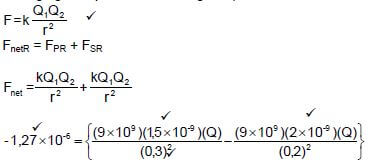
-1.27 x 10-6 = 150Q - 450Q (for subtraction)
Q = 4,23 x 10-9 C✔ (7)
Accept answers where left is taken as positive. [11]
QUESTION 8
8.1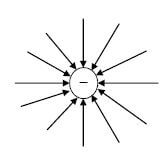
- Shape (radial) ✔
- Polarity (sign) of A✔
- Do not penalize for incorrect direction✔
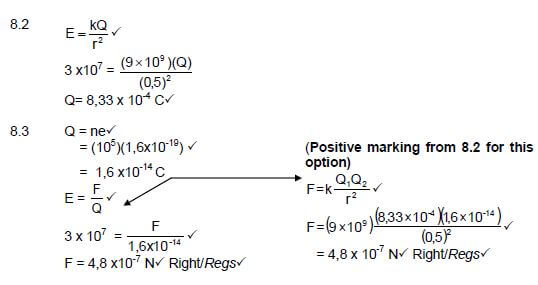 (3) , (6) [11]
(3) , (6) [11]
QUESTION 9
9.1.1
- The potential difference across a conductor is directly proportional to the current in the conductor at constant temperature.✔✔.
OR - The current in a conductor is directly proportional to the potential difference across the conductor at constant temperature. ✔✔ (2)
9.1.2 Graph X✔
- Graph X is a straight line (passing through the origin) therefore potential difference is directly proportional to current. ✔(2)
9.2.1
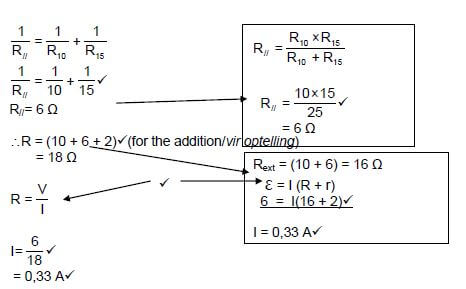 (5)
(5)
9.2.2 Decrease. ✔
- The total resistance of the circuit increases✔ (2)
9.2.3 Increase ✔ (1)
9.2.4
- The total resistance in the external circuit increases.✔
- Current decreases ✔
- ''Lost'' volts decreases ✔
OR - The total resistance in the external circuit increases.✔
- V α R for constant ✔
- Therefore V increases. (3) [15]
QUESTION 10
10.1 ANY THREE
- Permanent magnets
- coils (armature)
- commutator
- brushes
- power supply/battery (3)
10.2.1 The rms voltage of AC is the potential difference which dissipates the same amount of energy as the equivalent DC potential difference. ✔✔
Accept formula for Vrms as 1 mark. (2)
10.2.2 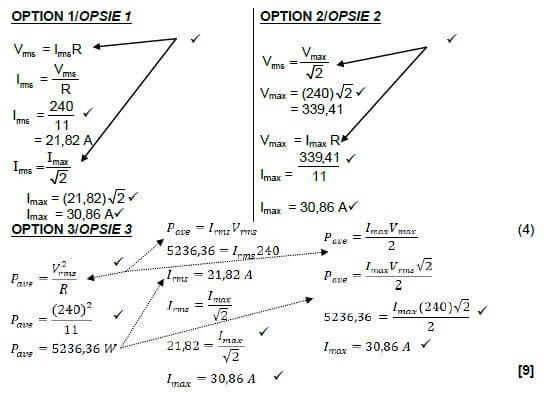
QUESTION 11
11.1.1 Greater than ✔
- Electrons are ejected from the metal plate ✔ Accept: a current is registered on the ammeter. (2)
11.1.2
- Increase in intensity means that (for the same frequency) the number of photons per second increases (ammeter reading increases)✔but the energy of the photons stays the same ✔(Therefore the statement is incorrect).
OR - An increase in the energy of the photons only increases the kinetic energy of the photoelectrons and not the number of photoelectrons, thus the ammeter reading will not change. (2)
11.1.3 Light has a particle nature. Accept light energy is quantized ✔ (1)
11.2.1The minimum frequency needed for the emission of electrons (from a metal surface). (2)
11.2.2
- W0 = hf0 ✔
= (6,63 x 10-34)(5,73 x 1014)✔
= 3,8 x 10-19J✔ [3,799 x 10-19 J] (3)
11.2.3 POSITIVE MARKING FROM QUESTION 11.2.2
OPTION 1
- E = W0 + Ek(max)
hf = hf0 + Ek(max)
hf = hf0 + ½ mv2
E = W0 + ½ mv2
✔ Any one - (6,63 x 10-34)f = 3,8 x 10-19 + [½(9,11 x 10-31)(4,19 x 105)2]✔
f = 6,94 x 1014 Hz✔ [7 x 1014 Hz]
OPTION 2
- E = W0 + Ek(max)
hf = hf0 + Ek(max)
hf = hf0 + ½ mv2
E = W0 + ½ mv2
✔ Any one - E = 3,8 x 10-19 + [½(9,11 x 10-31)(4,19 x 105)2]✔ hf = 4,599 x 10-19
(6,63 x 10-34)f = 4,599 x 10-19
f = 6,94 x 1014 Hz✔ [7 x 1014 Hz] (3) [13]
TOTAL: 150